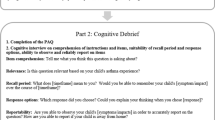Abstract
This paper reports the internal consistency and reproducibility of the Childhood Asthma Questionnaires, measures of quality of life and symptom distress in paediatric asthma. A total of 535 children aged 4–16 years completed age appropriate forms of the questionnaire, over 1-or 3-week intervals. Pearson correlation coefficients between 0.63 and 0.84 for subscales of the questionnaires indicated good test-retest reliability while intraclass correlation coefficients in a very similar range showed that scores also remained at the same level on the two occasions. Comparisons between children with asthma and healthy non-asthmatics indicate that these are likely to be true estimates of stability. Internal consistency varied widely but was higher for older children and longer subscales. Implications of the findings for the use of the questionnaires in the evaluation of new asthma treatments are discussed.
Similar content being viewed by others
References
Gallagher EB. Chronic illness management: A focus for future research applications. In: Gochman DS, ed. Health Behaviour: Emerging Research Perspectives. New York: Plenum Press, 1988.
Neri M, Spanevello A, Landoni CV, et al. Results of self management program in asthmatic patients. Am Rev Resp Dis 1992; 145(Suppl.): A183.
Prittwitz M, Hollander P, Betz H-P, et al. Patient training in rehabilitation of asthma, chronic obstructive bronchitis and emphysema improves lifequality and reduces hospitalisation rate, absenteeism from work and visits to the GI. Am Rev Resp Dis 1992; 145(Suppl.): A183.
Conboy K. Self-management skills for cooperative care in asthma. J Pediatr 1989; 115: 863–866.
Rakos RF, Grodek MV, Mack KK. The impact of a self-administered behavioural intervention programme on pediatric asthma. J Psychosom Res 1985; 29: 101–108.
Jaeschke R, Singer J, Guyatt GH. Measurement of health status: ascertaining the Minimal Clinically Important Difference. Controlled Clin Trials 1989; 10: 407–415.
Schipper H, Clinch J, Powell V. Definitions and conceptual issues. In: Spilker B, ed. Quality of Life Assessments in Clinical Trials. New York: Raven Press, 1990.
Shumaker SA, Anderson RT, Czajkowski SM. Psychological tests and scales. In: Spilker B, ed. Quality of Life Assessments in Clinical Trials. New York: Raven Press, 1990.
Usherwood TP, Scrimgeour A, Barber JH. Questionnaire to measure perceived symptoms and disability in asthma. Arch Dis Childh 1990; 65: 779–781.
Taylor GH, Rea HH, McNaughton S, et al. A tool for measuring the asthma self-management competency of families. J Psychosom Res 1991; 35: 483–491.
Beitchman JH, Corradini A. Self-report measures for use with children: a review and comment. J Clin Psychol 1988; 44: 477–490.
Spykerboer JE, Donnelly WJ, Thong YH. Parental knowledge and misconceptions about asthma: a controlled study. Soc Sci Med 1986; 22: 553–558.
Schlosser M, Havermans G. A Self-Efficacy Scale for children and adolescents with asthma: construction and validation. J Asthma 1992; 29: 99–108.
Christie MJ, French D, Weatherstone L, et al. The patients' perceptions of chronic disease and its management: Psychosomatics, holism and quality of life in contemporary management of childhood asthma. Psychother Psychosom 1991; 56: 197–203.
Christie MJ, French DJ, Sowden A, et al. The development of child-centred, disease-specific, questionnaires for contemporary appraisals of living with asthma. Psychosom Med 1993; 55: 541–548.
Harris PL, Guz GR, Lipian MS, et al. Insight into the time course of emotion among Western and Chinese children. Child Dev 1985; 56: 972–988.
French DJ, Christie MJ, West A. Some psychometric properties of a questionnaire measure of quality of life (QOL) in childhood asthma. Am Rev Resp Dis 1992; 145(Suppl.): A707.
Cronbach LJ. Coefficient alpha and the internal structure of tests. Psychometrika 1951; 16: 297–334.
Achenbach TM, McConaughy SH, Howell CT. Child/adolescent behavioural and emotional problems: Implications of cross-informant correlations for situational specificity. Psychol Bull 1987; 101: 213–232.
Edelbrock C, Costello AJ, Dulcan MK, et al. Age differences in the reliability of the psychiatric interview of the child. Child Dev 1985; 56: 265–275.
Johnson SB. Methodological considerations in pediatric behavioral research: measurement. J Dev Behav Pediatr 1991; 12: 361–369.
Deyo RA, Diehr P, Patrick DL. Reproducibility and responsiveness of health status measures, statistics and strategies for evaluation. Controlled Clin Trials 1991; 12: 142S-158S.
Guyatt GH, Jaeschke R. Measurements in clinical trials: choosing the appropriate approach. In: Spilker B, ed. Quality of Life Assessments in Clinical Trials. New York: Raven Press, 1990.
Kazdin AE, Petti TA. Self-report and interview measures of childhood and adolescent depression. J Child Psychol Psychiatr 1982; 23: 437–457.
Saylor CF, Finch AJ, Spirito A, et al. The Children's Depression Inventory: a systematic evaluation of psychometric properties. J Consult Clin Psychol 1984; 52: 955–967.
Pearson R. Asthma: Management in Primary Care. Oxford: Radcliffe Medical Press, 1990.
Gaito J. Measurement scales and statistics: resurgence of an old misconception. Psychol Bull 1980; 87: 564–567.
Borgatta EF, Bohrnstedt GW. Level of measurement, once over again. Sociol Meth Res 1980; 9: 147–160.
Wheeler VA, Ladd GW. Assessment of children's self-efficacy for social interactions with peers. Dev Psychol 1982; 18: 795–805.
Hester NO. Child's health self-concept scale: its development and psychometric properties. Adv Nurs Sci 1982, 7: 45–55.
Evans C. An introduction to the methods of testing measures of quality of life. In MJ Christie and DJ French (eds) The Assessment of Quality of Life in Childhood Asthma. Chichester: Carden, 1993.
Smucker MR, Craighead WE, Craighead LW, et al. Normative and reliability data for the Children's Depression Inventory. Abnormal Child Psychol 1986; 14: 25–39.
Walker LS, Greene JW. The Functional Disability Inventory: Measuring a neglected dimension of child health status. J Pediatr Psychol 1991, 16: 39–58.
Juniper EF, Guyatt GH, Ferrie PJ, et al. Measuring quality of life in asthma. Am Rev Resp Dis 1993; 147: 832–838.
Author information
Authors and Affiliations
Rights and permissions
About this article
Cite this article
French, D.J., Christie, M.J. & Sowden, A.J. The reproducibility of the Childhood Asthma Questionnaires: measures of quality of life for children with asthma aged 4–16 years. Qual Life Res 3, 215–224 (1994). https://doi.org/10.1007/BF00435387
Accepted:
Issue Date:
DOI: https://doi.org/10.1007/BF00435387




